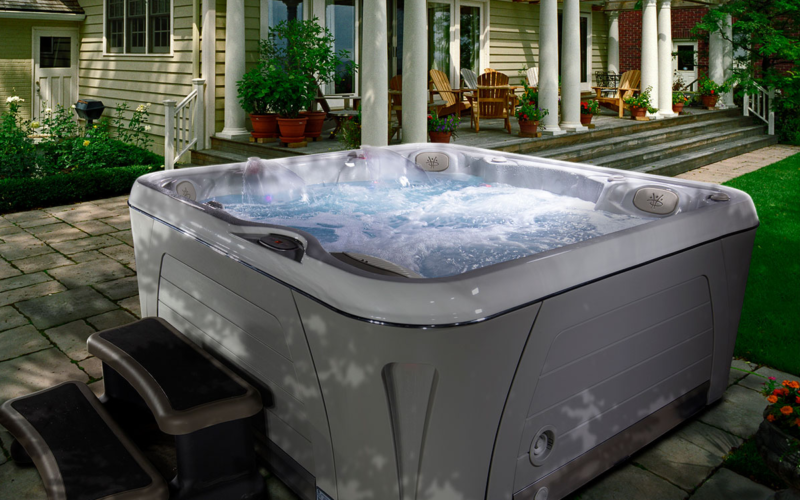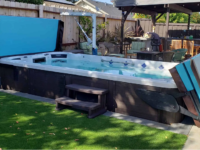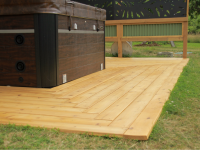If you have ever considered buying a new hot tub, you will understand that this is not an easy decision; after all, hot tubs are a luxury item. When purchasing a new hot tub, you’ll want one that won’t break down a few years after you begin using it. You’ll want to get the most out of your purchase. So understanding the average life of a hot tub and what factors influence the lifetime will help you to choose one that is right for you.
What is the average life expectancy of a hot tub?
Depending on many factors, the life of a spa can range anywhere from 5 to 20 years.
Do you want to make your hot tub last 3 times longer?
90% of success is in proper hot tub maintenance. To avoid (or prevent further) leaks, you should follow the hot tub care schedule and use the proper chemicals.
We know how it may seem confusing; that’s why our team has created a complete hot tub care guide and we reveal the tricks that the manufacturers would like to keep secret.
When looking at the longevity of any hot tub you must consider the daily wear and tear on the plastic parts, the water pump, the heater, and also the cover. Your tub could last past 20 years if you pay attention and replace parts before they wear out. If you don’t care about looking after the components, you will struggle to get even five years from it.
Life expectancy of different hot tub parts:
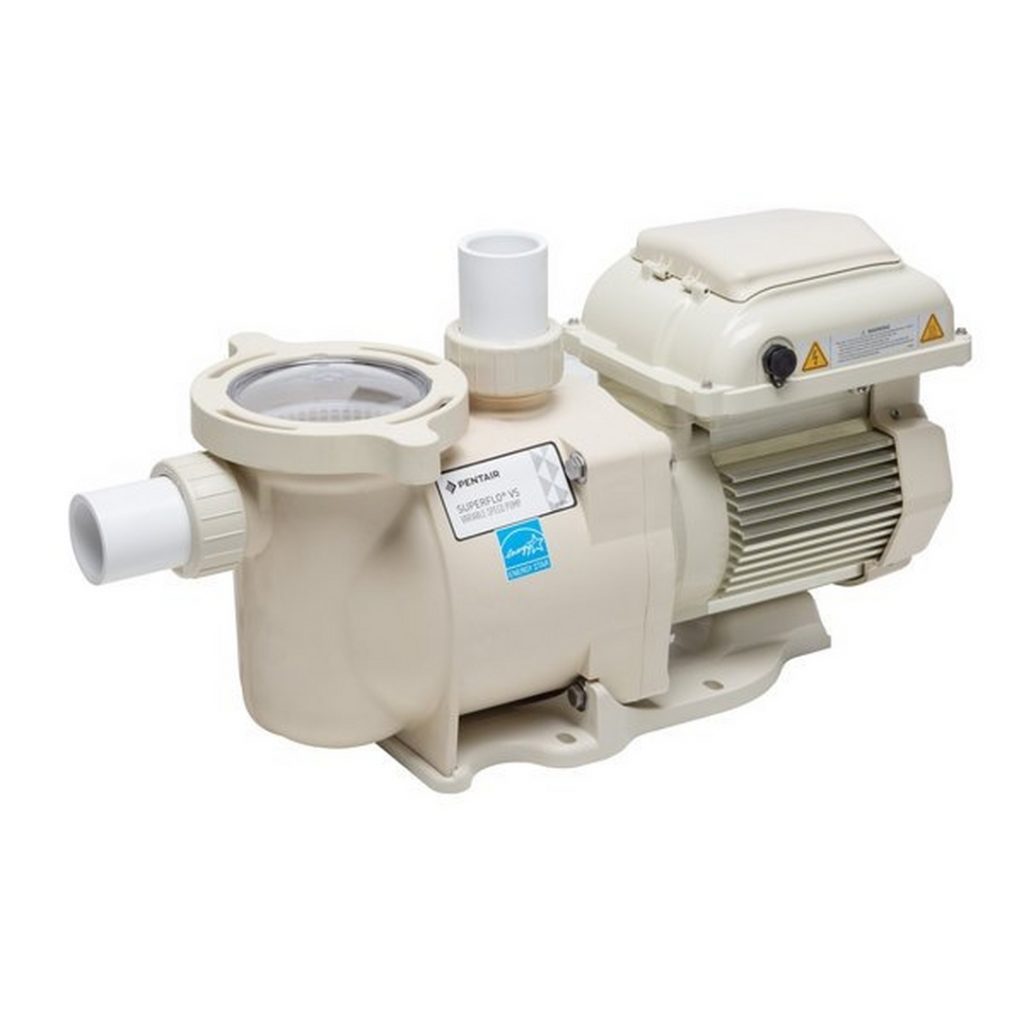
Pump
5 – 10 years
A pump is the most common component from where leaks initiate. If you find water there, you would have to replace the pump seal and maybe the pump itself (if required).
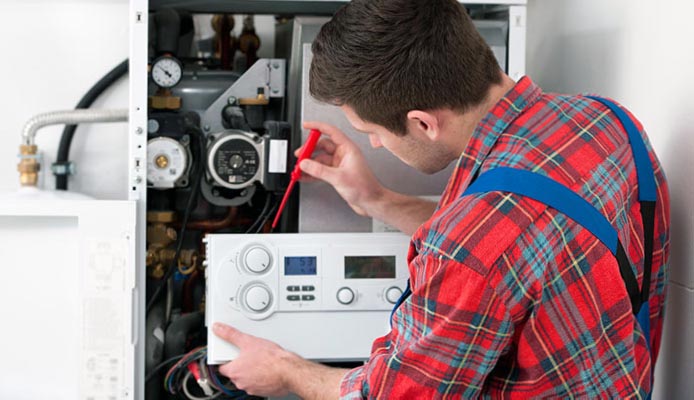
Heater
5 – 7 years
The heating assembly contains the heater, other components, and the pressure switch. If any of these components failed, they might need to be repaired or replaced.
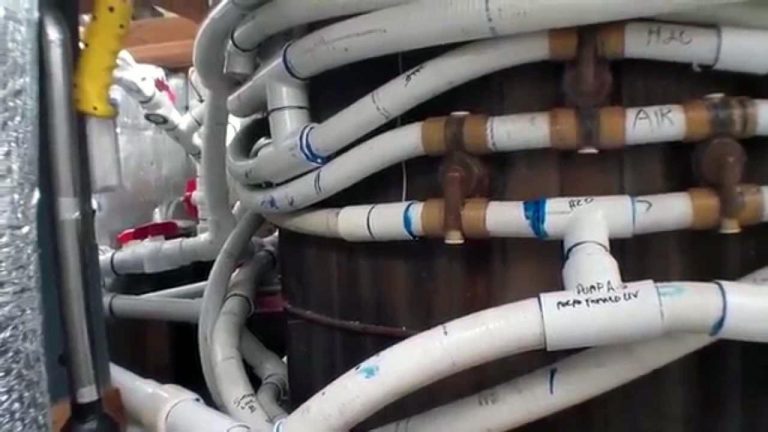
Pipes
2 – 5 years
If there is a bump (or any damage) in the PVC pipes, it can easily be repaired with liquid binder glue (Plast-Aid). The glue expands, hardens, and becomes stronger than PVC itself.
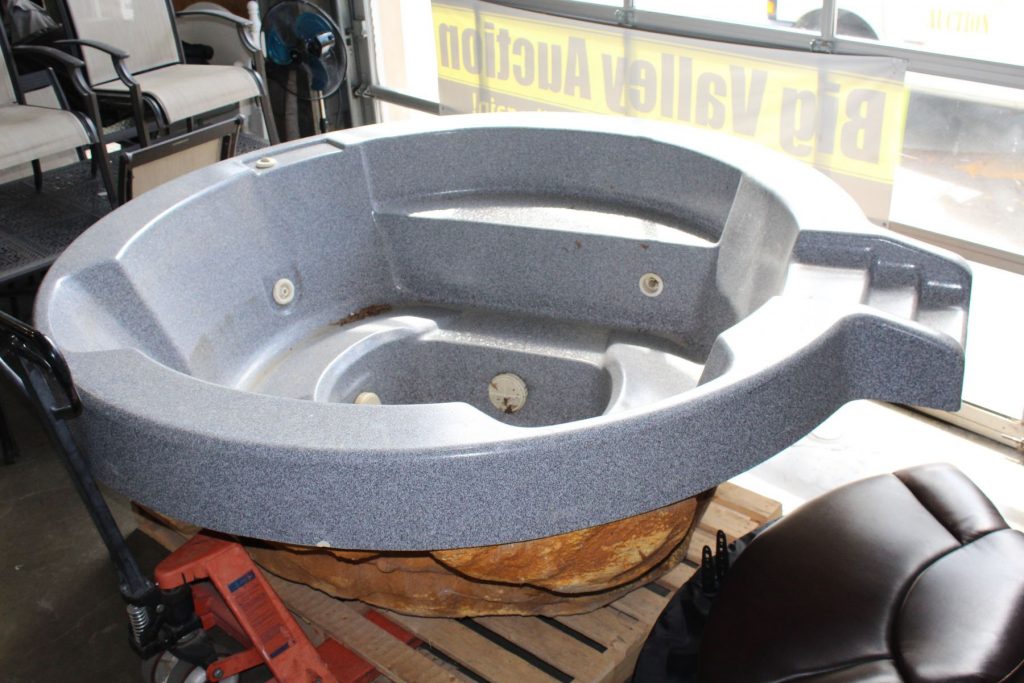
Hot tub shell
Up to 20 years
Hot tub shells are manufactured using strong fiberglass combined with layers of other substances which makes breakages very rare.
If the shell has visible cracks, they can easily be repaired with an acrylic and PVC repair kit.
What Factors Influence the Life of your Hot Tub?
Let’s outline what factors may influence the life of your hot tub, and then we will look at what you can do to maximize your experience with yours.
1. How you maintain your tub
It might seem obvious; how often you clean or maintain your spa will greatly affect how long it will last. If you buy it, use it, and hope that you won’t run into any problems with your one, then life will be shorter.
But if you give it regular maintenance, it will last much longer. They are not built to last forever, but mechanical parts of the tub, such as the pump and the heater, will need regular maintenance if you expect them to keep running well.
2. The effect that the chemicals have on the internal parts
So what effect will the chemicals have on how long your spa will last? There are a number of chemicals that need to be added to keep the water crystal clear and safe to use.
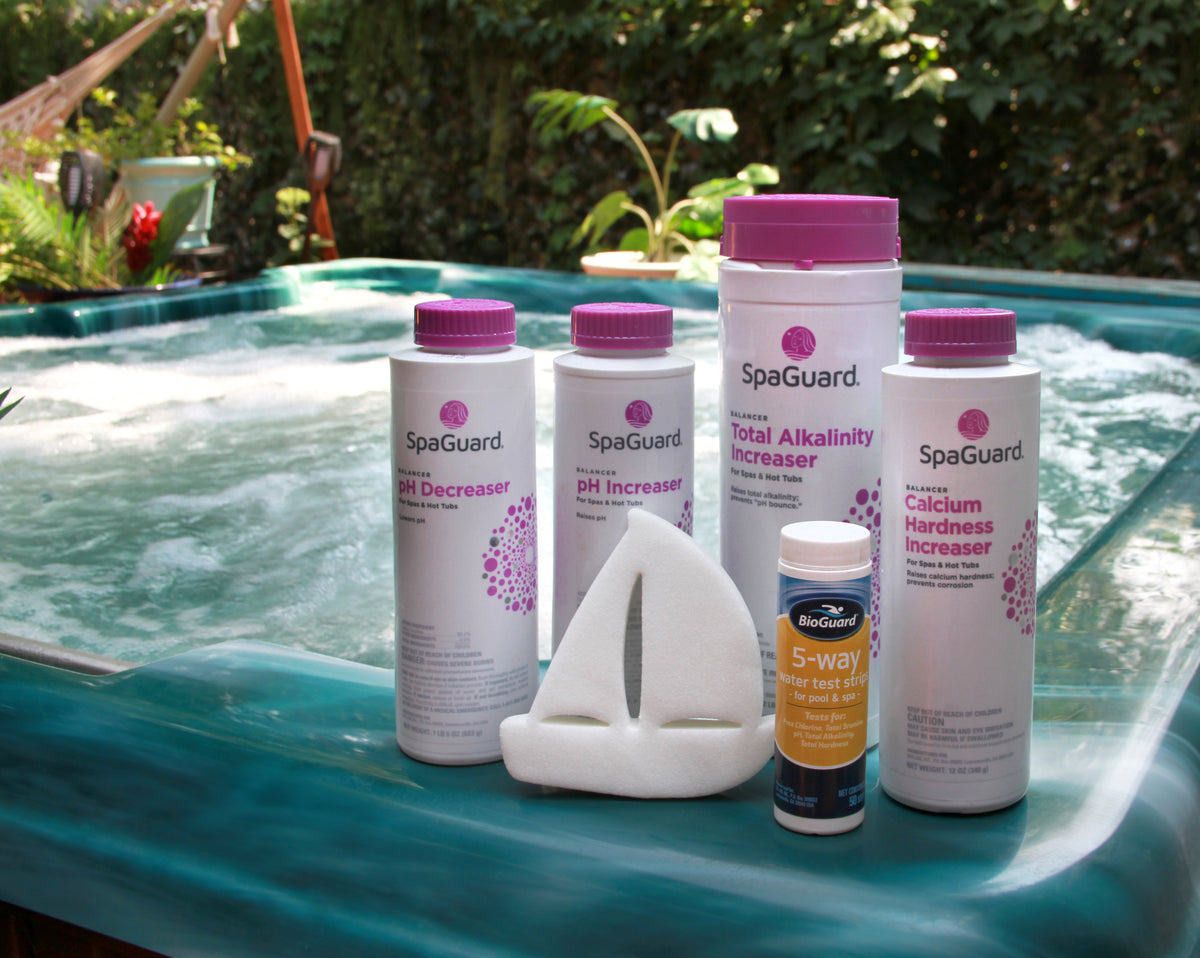 | Chemical Starter Pack A number of chemicals that need to keep the water crystal clear and safe to use. |
Sanitizers
Sanitizers are chemicals that keep the warm water bacteria-free and keep the water smelling fresh. The most common types of sanitizers are Bromine and Chlorine.
Chlorine should be in the range of 1.5 – 3.0 PPM and Bromine should be in the range of 3.0 – 5.0 PPM.
Spa Shock
Spa Shocks are usually treatments that eliminate the smells and reduce irritants from your water. It’s important to note that the more you use the hot tub, the more sanitizer and oxidizers you will need to keep the water clean.
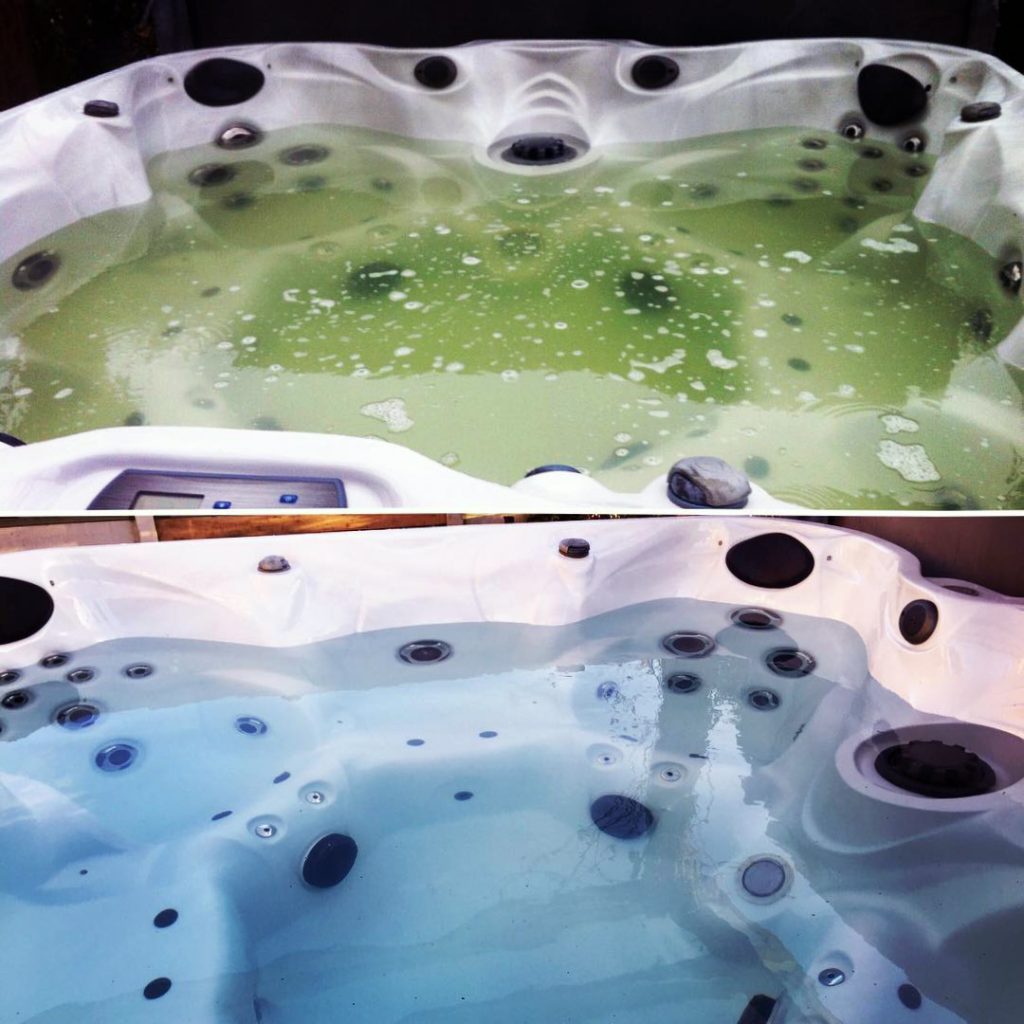
pH Level
Keeping the pH level in balance is one of the most important things to consider when maintaining your spa. If you do not keep it in check, you will run the risk of damaging the equipment, like the heating elements and the pump seals.
If the pH is too low, you run the risk of corrosion of the metal parts and destruction of the total alkalinity. If the pH is too high, you run the risk of the formation of scale on the tub surface, and the filters will have a shorter run.
To get the most use out of your hot tub, you will want to keep the PH between 7.2 and 7.8.
Total Alkalinity
If the total alkalinity is too high, it will be too hard to balance the pH of your tub, but if it is too low, the pH will change too rapidly. Total alkalinity is connected with the pH level of the tub and should be kept between 80 – 120 PPM.
Calcium Hardness
The final thing that you need to consider when getting the chemicals in balance is the calcium hardness, or total hardness, of the water.
If it does not have enough calcium, the water will draw other minerals from the metal parts of your hot tub. This includes the heating elements, pump seals, and other internal parts. This will lead to the corrosion of these parts.
If the hardness is too high, you will notice the formation of a scale on the tub’s internal components, and the water will take on a cloudy look.
For ideal operation, you should keep the hardness between 100 – 450 PPM, depending on the type of finish that your chosen hot tub has.
Let’s repeat once again: to keep getting the most of your traditional hot tub, you need to keep testing the water regularly.
| Parameter | Required range |
| Chlorine | 1.5 – 3.0 PPM |
| Bromine | 3.0 – 5.0 PPM |
| pH level | 7.2 – 7.8 PH |
| Calcium Hardness | 100 – 450 PPM |
You can easily monitor these parameters with test strips or digital meters.
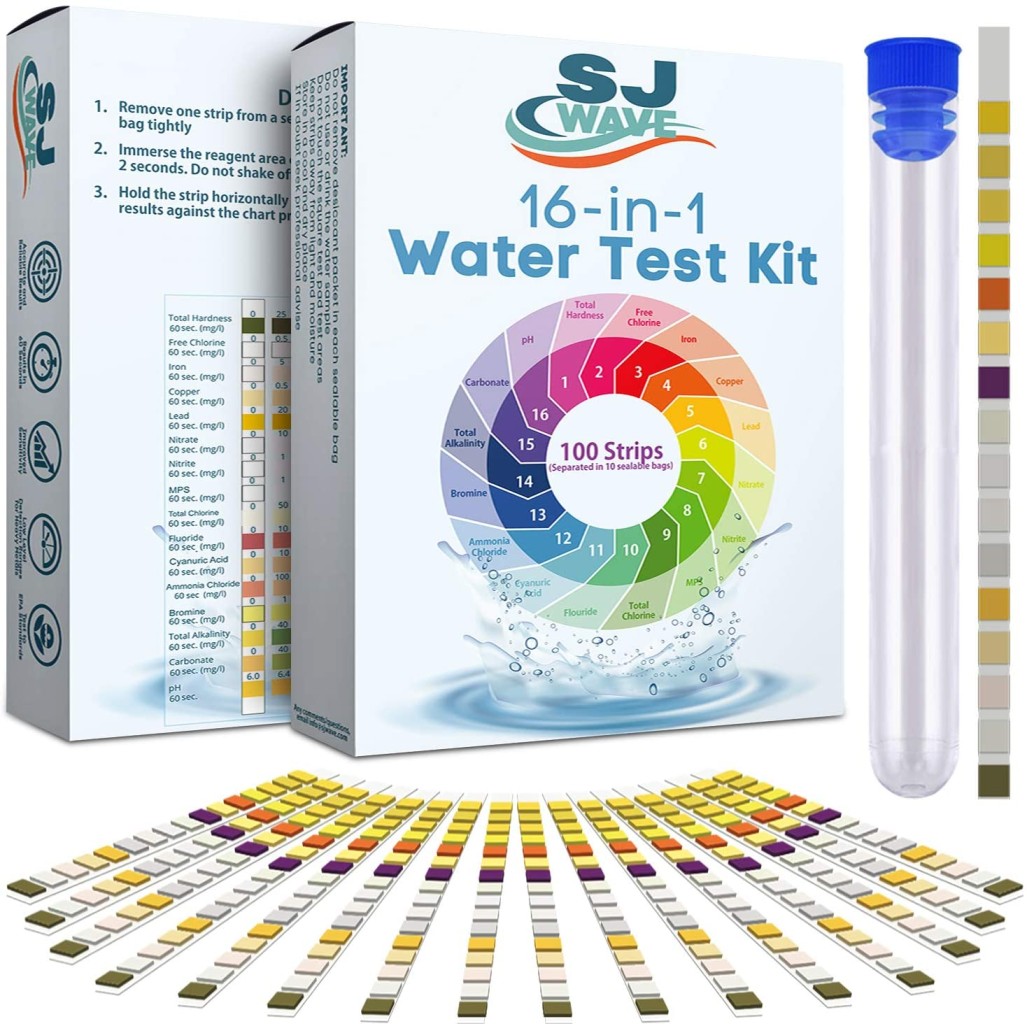 | Test Strips Test Strips detect pH, Hardness, Chlorine, Lead, Iron, Copper, Nitrate | |
 | Digital Test Meter Fast and accurate measure pH, Free Chlorine, Salt, TDS, ORP and Temperature |
3. Inside vs. Outside
Does your decision for an indoor or outdoor spa affect the lifespan? When deciding if you will have the tub indoors or outdoors, we don’t always consider the differences in maintenance. Most outdoor hot tubs are built in such a way that they will be durable to most types of weather. Let’s look at the advantages and disadvantages of keeping the hot tub indoors or outdoors.
Indoors
An indoor spa gives you the added advantage of privacy, and you can enjoy a soak in your hot tub without worrying who is watching you. It also makes it convenient to use at any time. An indoor hot tub is protected from the elements; the shell and cover will remain unblemished from nature.
The inconvenience of having your tub indoors is that installing it will cause you to make changes to the room that you put it in. An indoor tub has to have good drainage and a faucet for refilling. You will also require a space that has sufficient ventilation, so the damp air will not cause damage to the walls and floor. You will also want to consider water-resistant building material.
Outdoors
The convenience of having your tub outdoors is that they are easier to install and maintain. You will not have to worry about ventilation or the drainage issues, as you have unlimited natural ventilation and drainage.

You’ll have to consider the lack of privacy and natural factors; otherwise, there aren’t huge disadvantages in owning an outdoor tub.
Does the type of water affect the average lifetime?
Three main types of spa water care are available for owners of spas.
There is the traditional spa water care, which is the most manual and the cheapest option. There is also Ozone with MPS and Silver Ions, which requires a little less attention and uses less chlorine.
Finally, there are the saltwater systems which requires the least attention but is the most expensive option. Which option will affect the lifetime of your tub?
Saltwater Systems
With the saltwater tub, you do not need to add any chemicals to the water, as it creates its natural chlorine to keep the water clean. The saltwater tub has an initial cost that ranges from $500 – $5,000 more than traditional tubs.
Any spa can be a saltwater tub if you add a saltwater chlorine generator. They may be more expensive to set up, but the maintenance costs, in the long run, are cheaper. In addition, you get all the benefits of a hot tub without the effects of the chlorine.
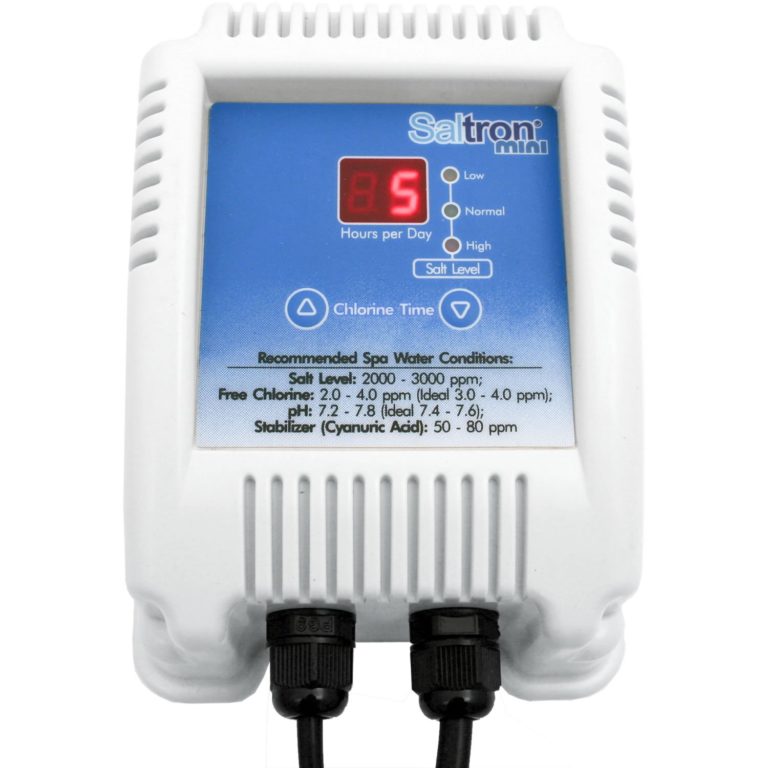 | Saltwater Chlorine Generator Chlorine generator to convert any hot tub into a seawater system. |
So how can a saltwater tub be more difficult to use? The saltwater system looks like a good alternative, but if you don’t do regular maintenance, things can and will go wrong.
Replacing the salt cells adds another cost to the maintenance of your hot tub. The saltwater can also add to the risk of the corrosion of different elements in your tub, so you need to regularly take cake care to wipe down different parts of your hot tub.
Finally, for the hot tub to produce the natural chlorine, the water needs to be kept at 60F, or the system that makes the chlorine will not work correctly.
So, is this type of spa is right for you? If you are looking for a more gentle hot tub experience and a tub that is more comfortable and cheaper to maintain, then this might be the system for you, even if the initial set up may cost a little more.
Does the brand affect the lifetime of a hot tub?
When buying a tub, is it essential to consider the brand and or price as a factor in the life of your hot tub?
The simple answer is yes!
If you are buying from a reputable spa dealer, you get more than just a spa; you get a relationship that will help you before and after your purchase.
If you are buying from a reputable dealer, they will offer you a range of services that include consultation and installation, hot tub maintenance, and service visits.
These added on benefits will add to the cost, but will help you to enjoy your hot tub for much longer.
Check what warranty is offered
They type and length of the warranty offered for the product can say a lot about the quality of the tub. It will show just how confident they are in their product, as a company will not want to pay out heaps of money in repairs or replacements every few years if they expect their product to break down frequently.
You should also check the details that the warranty includes; does it cover only the main parts of tubs or does it cover all the smaller features and internal workings of the spa? The more extensive the warranty, the more confident they are that their product will last!
What type of service support is offered with your spa?
When deciding on the quality of a tub, you should also take a look at the type of after-sales service the company offers. You will know the company that has a lot of faith in their product if they provide you an after-sales service that promises to fix any problem that arises with your hot tub. And even if their product does not meet expectations and they have the after-sales support, you will feel much more comfortable using their products than those from the companies that offer minimal after-sales support.
Other
Other factors that you should look at when buying your spa are the energy efficiency, the quality, the size, and features.
When deciding on your hot tub, you will want a hot tub that is energy efficient, which will keep the electricity costs lower.
The higher upfront cost of any hot tub generally means that it is better quality and therefore you will be able to enjoy your hot tub longer. Another factor that will influence the price is the size. Smaller hot tubs are cheaper to produce, which means they will be less expensive for you to purchase.
You will also need to consider the features that your hot tub has. Features that may increase the cost of your hot tub include extra jets, lighting, steps, umbrellas, remote control, removable spa pillows, and advanced water care technology.
How can you add life to your hot tub?
With every substantial investment, the buyer should be aware that to get the most from your purchase, you need to consider taking setting a schedule based on how often you use it.
When you purchase a car, you know that good maintenance will allow you to maximize the use that you get from your vehicle. The same goes for your hot tub. So what type of cleaning schedule should you look at that will help you get the maximum use from the tub?
Some products that will be useful for hot tub owners:
 | Chemical Starter Pack A number of chemicals that need to keep the water crystal clear and safe to use. | |
 | Test Strips Test Strips detect pH, Hardness, Chlorine, Lead, Iron, Copper, Nitrate | |
 | Digital Test Meter Fast and accurate measure pH, Free Chlorine, Salt, TDS, ORP and Temperature | |
 | Saltwater Chlorine Generator Chlorine generator to convert any hot tub into a seawater system. | |
| Cartridge Cleaner Quickly removes oil, grease and calcium from filters |
According to swimuniversity.com, we should think of a spa as a tiny swimming pool, so proper maintenance should follow the three C’s:
- circulation
- cleaning
- chemistry
When you keep your tub peak operating condition, it will prevent costly repairs and extend the life of the hot tub. This will provide a safe soaking environment.
1. Daily Maintenance
Testing the sanitizer is one of the important aspects of keeping your tub working and should be done on a regular basis.
You should also put a cover on your hot tub when you don’t use it to keep the dust out, the energy bill small, the children safe and your pets dry.

Source: Twitter
Owners should aim at keeping the water temperature around 100 – 104F. The water should remain above the water intake line to keep it circulating probably.
A spa vacuum once a day will keep debris from collecting on the bottom of your tub or out of the filters.
If you take time to complete these regular tasks, you will get much more enjoyment from your tub.
2. Weekly Maintenance
Once a week, owners of spas should undertake the following checks and maintenance.
First, you should test the pH, alkalinity, and salinity levels and keep them in the recommended ranges. If they are not in balance, it could be unsafe for use and cause damage to your hot tub.
Next, clean both the water lines and the shell that is exposed to the water to keep the scum from building up on the surface.
Finally, you should check the hot tub filter and clean it if necessary. For this, you may need Cartridge Cleaner Care. If you have a filter that is clean, the water will be crystal clear.
| Cartridge Cleaner Quickly removes oil, grease and calcium from filters |
3. Monthly Maintenance
Now that you’ve been checking it regularly, you should complete the following maintenance of your tub at least once a month.
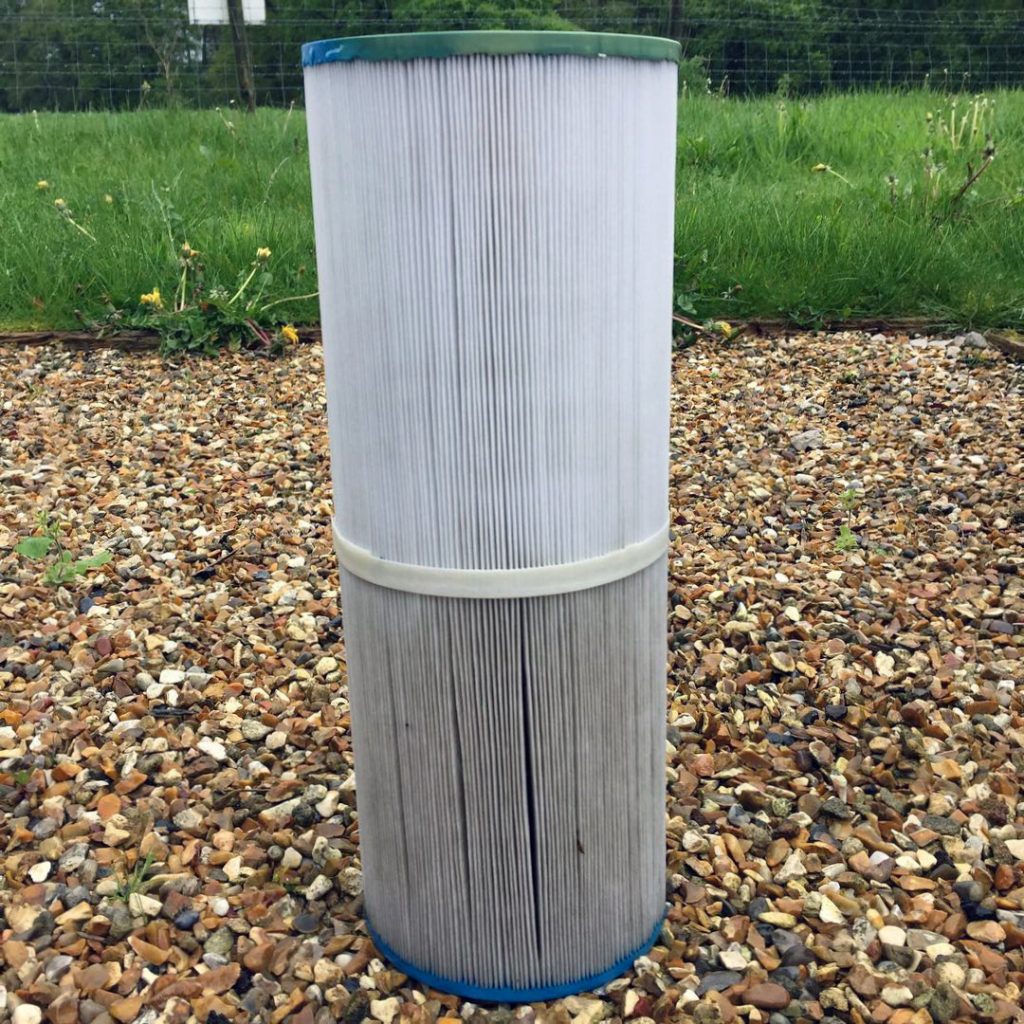
First, you need to clean the filter. Next, you should wipe down the inside and outside surfaces of your tub cover. Finally, you should check for any issues with the calcium hardness, and if you have problems, you should take measures to correct this.
4. Yearly Maintenance
Now you have been cleaning and checking regularly, you will be able to catch any problems with the individual parts. At least once a year you should complete the following maintenance on your tub.
Drain and clean your hot tub and flush out the plumbing system to remove any debris. At this time you should give it a professional inspection to keep on top of any significant problems with your tub.
Summary
It seems that the big thing to getting the most of any hot tub is the maintenance that it requires. Cheap or expensive, chlorine or salt water, it doesn’t matter as much as how much time you are going to spend maintaining your tub. You should consider a tub as a small pool, and to get the most out of it, you need to be prepared to put in the proper maintenance
Useful products for hot tub owners:
 | Chemical Starter Pack A number of chemicals that need to keep the water crystal clear and safe to use. | |
 | Test Strips Test Strips detect pH, Hardness, Chlorine, Lead, Iron, Copper, Nitrate | |
 | Digital Test Meter Fast and accurate measure pH, Free Chlorine, Salt, TDS, ORP and Temperature | |
 | Saltwater Chlorine Generator Chlorine generator to convert any hot tub into a seawater system. | |
| Cartridge Cleaner Quickly removes oil, grease and calcium from filters |
FAQ
⌚️ How many years should a hot tub last?
The lifespan of a spa can range anywhere from 5 to 20 years. If you fail to clean and maintain your hot tub properly, there’s no way it’ll last even five years. However, with the right attention and care, it could last well beyond 20 years. When you consider the longevity of any hot tub, you must consider the daily wear and tear on the plastic parts, the water pump, the heater, and also the cover.
⏰ How does maintenance affect the longevity of the spa?
The most significant factor is the maintenance that is required. You can purchase the most expensive model, but without proper maintenance, it will not last you long. That being said, you can get a low-end model. If you spend some time and effort on maintenance, you can enjoy the hot tub for many years.
🏠Will the jacuzzi last longer if you put it indoors?
An indoor hot tub is somewhat more protected than having an outdoor tub. The shell and cover of the tub will remain unblemished from nature. An indoor tub requires proper drainage and a faucet for refilling. You will also require a space that has sufficient ventilation so that the damp air does not damage the walls and the floor.
👻 Does the brand affect the lifetime of a hot tub?
Definitely! If you are buying from a reputable spa dealer, you’ll get more than just a spa; you’ll get a relationship that will help you before and after your purchase. You will also receive a range of services that include consultation and installation, hot tub maintenance, and service visits. A good brand will ensure that you can make the most of your hot tub for a long time.
🕔 How can I make my hot tub last longer?
Good maintenance should follow the three C’s; circulation, cleaning, and chemistry. And according to saltwaterpoolandspa.com, when you keep your tub in peak operating condition, it will prevent costly repairs and will extend the life of the hot tub. This will provide a safe soaking environment.
🐳 How does saltwater affect a Jacuzzi?
Saltwater can add to the risk of the corrosion of different elements in your tub. That is why you should regularly wipe down the different parts of your hot tub. To produce natural chlorine, the water needs to be kept at 60F, or the system that makes the chlorine will not work correctly.
Sources:
1. “Hot Tub Maintenance and Care Guide.” Saltwaterpoolandspa.com, www.saltwaterpoolandspa.com/hot-tub-maintenance.html.
2. September 19, 2018. “Outdoor vs. Indoor Hot Tubs Pros and Cons.” Hot Spring Spas, www.hotspring.com/blog/outdoor-vs-indoor-hot-tubs-pros-and-cons.
3. Render, Jessica. “They’re Gentler and Easier to Maintain, but Come at a Higher Cost.” ConsumerAffairs, ConsumerAffairs, 21 May 2019, www.consumeraffairs.com/homeowners/saltwater-hot-tub-pros-and-cons.html
4. “A Beginner’s Guide to Hot Tub Maintenance.” Swim University®, 5 Apr. 2019, www.swimuniversity.com/hot-tub-maintenance/.
5. “Understanding Spa and Hot Tub Water Chemistry / Spa Care.” Spacare, www.spacare.com/understandingspaandhottubwaterchemistry.aspx
6. “What Makes One Hot Tub More Expensive Than The Other?” Hot Spring Spas, www.hotspring.com/what-makes-one-hot-tub-more-expensive-other.
